Toyota Highlander
The Toyota Highlander, also known as the Toyota Kluger (Japanese: トヨタ・クルーガー, Toyota Kurūgā), is a mid-size crossover SUV produced by Toyota. It is built on the same platform as used on the Camry.[1]
| Toyota Highlander | |
|---|---|
_GXL_wagon_(2018-09-17)_01.jpg) 2018 Toyota Kluger GXL wagon (GSU55R, Australia) | |
| Overview | |
| Manufacturer | Toyota |
| Also called | Toyota Kluger (Japan, 2000–2007; Australia, 2000–2019) |
| Production | 2000–present |
| Model years | 2001–present |
| Body and chassis | |
| Class | Mid-size crossover SUV |
| Body style | 5-door SUV |
| Layout |
|
Announced in April 2000 at the New York International Auto Show and arriving in late 2000 in Japan and January 2001 in North America, the Highlander became one of the first car-based mid-size SUV or mid-size crossovers.[2] The Highlander is the crossover counterpart to the more rugged, truck-based mid-size 4Runner and became Toyota's best-selling SUV before being surpassed by the smaller RAV4 in 2006. In Japan, the Kluger is exclusive to dealership network called Toyota NETZ as a larger alternative to the RAV4.
Unable to use the Highlander nameplate in Japan and Australia because of a trademarked Hyundai Terracan trim line, Toyota calls the vehicle the Toyota Kluger (pronounced Klu-ger) there. The name is derived from the German word klug, which means smart or clever ("Kluger" meaning "one who is smart").[3]
First generation (XU20; 2000–2007)
| First generation (XU20) | |
|---|---|
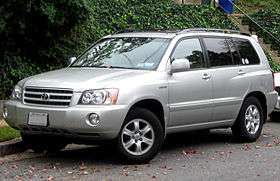 | |
| Overview | |
| Also called | Toyota Kluger (Japan and Australia) |
| Production | November 2000 – May 2007[4] |
| Model years | 2001–2007 |
| Assembly | Japan: Miyawaka, Fukuoka (Miyata plant)[4] |
| Body and chassis | |
| Platform | Toyota K platform |
| Powertrain | |
| Engine | |
| Transmission |
|
| Dimensions | |
| Wheelbase | 2,715 mm (106.9 in) |
| Length |
|
| Width | 1,826 mm (71.9 in) |
| Height |
|
| Curb weight | 1,716 kg (3,784 lb) |
| Chronology | |
| Successor | Toyota Vanguard (XA30) (for Kluger, Japan) |
The Highlander (or Kluger in Japan and Australia) shared a platform with its XU30 series Lexus RX/Toyota Harrier cousin. It came in five (2001–2007) and seven-seat (2004–2007) configurations and became a sales success for Toyota in a number of markets across the world. The Highlander came standard with front wheel drive and offered all wheel drive (50:50 front:rear fixed torque split). Unlike Toyota's own 4Runner and other mid-sized competitors such as the Jeep Grand Cherokee, or Chevrolet TrailBlazer, the Highlander aimed for on-road comfort with its unibody construction and independent rear suspension. Although it was longer than the 1996–2002 4Runner available at the time it was launched, the Highlander was surpassed in length by the redesigned 4Runner in 2002.
The Highlander was available in three trim lines in the United States: the base model, the Sport model, and the Limited model. The base and Limited models were present when the Highlander was initially introduced, while the Sport model was introduced in March 2006. In Japan, it is regarded as a luxury vehicle as the Kluger exceeds Japanese Government regulations regulating engine displacement and exterior dimensions.
In 2004 the wheels on the Limited trim changed from a six-spoke to a five-spoke alloy. The base-model Highlander wheels also changed from steel-rims to the alloy wheels that were on the 2001–2003 model year Highlander Limited and B-Package. The Sport models had a distinctive grille design, differentiating themselves from the non-Sport models. Wheel styling also serves to differentiate the various models—the hybrid sports a unique twin-spoke design.
The Kluger was introduced to Australia in October 2003. It was available in three guises: CV, CVX, and Grande. A limited edition CV Sport model was also released in 2006. There was no hybrid model available in Australia. The only engine offered was the 3.3-liter 3MZ-FE V6. Typical fuel economy using the Australian standard testing regime is 12.3 L/100 km (23.0 mpg‑imp; 19.1 mpg‑US).
Engines:
- 2001–2007 2.4 L 2AZ-FE I4,116 kW (155 hp)
- 2001–2003 3.0 L 1MZ-FE V6, 151 kW (203 hp)
- 2004–2007 3.3 L 3MZ-FE V6, 168 kW (225 hp)
The 3.0-liter engine was able to propel the Kluger from 0–60 mph in approximately 8.8 seconds. In 2004 the Kluger was given a new 3.3-liter V6 engine to compete with the more powerful V6 offerings from its competitors, mainly the Nissan Murano and the Honda Pilot. The larger engine made it possible for the Kluger to reach 0 to 97 km/h (60 mph) in 7.8 seconds.
2001 update
The Japanese and Australian Kluger was released with a center console integrated with the dashboard, while the North American Highlander initially lacked this integrated center console. The integrated center console was introduced in all US Highlanders and in Canadian Limited Highlanders in 2001, for the 2002 model year, and in all Canadian Highlanders in 2003, for the 2004 model year. However, for these early Highlanders without the integrated center console, a smaller non-integrated stand-alone center console was available as an option, which was installed at the factory or could be installed by the dealer.
2003 update
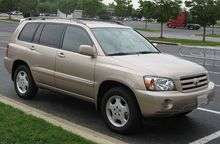
_Grande_wagon_(2011-06-15)_02.jpg)
In 2003, for the 2004 model year, in addition to the 3.3-liter engine, V6-powered models were equipped with a new five-speed automatic transmission, replacing the four-speed automatic transmission, while the inline-four models continued to use the old four-speed. This year also saw the introduction of the optional third row seat allowing for two additional passengers. The center console, which was previously exclusive to the top trim level, is now standard across all trims. The unibody was slightly modified behind the second row seats to include a depression in the trunk floor able to accommodate the optional third row seating. On models without third row seating, this depression was turned into a storage compartment (prior to 2004 the spare tire was accessible from inside the vehicle where the third row seating would subsequently be located; beginning in 2004 the spare tire is accessible from underneath the vehicle). Subtle changes to the front grille, front and rear bumpers, headlights and taillights (LED taillights on later hybrid models) round-out the major changes for the 2003 mid-cycle refresh.
2005 update
In 2005, for the 2006 model year, Highlanders sold in Canada were offered only in a V6 all-wheel drive configuration. Hybrid models were available with part-time four-wheel drive, which Toyota refers to as 4WD-i whereby the rear wheels are powered by a separate electric motor. This system is intended for use on snow and ice and is prone to overheating the rear electric motor off-road.[5]
Safety
Anti-lock brakes, brake assist and electronic brakeforce distribution were standard, Vehicle Stability Control w/traction control optional on 2001–03 models became standard for 2004 models (Hybrids come standard with VDIM). Also standard for 2004 was a tire pressure monitor. Front seat-mounted side torso airbags were optional on 2001–06 models, while front and second row side curtain airbags were optional on 2004–06 models. Side airbags became standard on 2007 models and the curtain airbags gained a rollover sensor that year as well.
| Frontal Driver: | |
| Frontal Passenger: | |
| Side Driver: | |
| Side Rear Passenger: | |
| Rollover: |
| Frontal Driver: | |
| Frontal Passenger: | |
| Side Driver: | |
| Side Rear Passenger: | |
| Rollover (2005):[8] |
In Insurance Institute for Highway Safety (IIHS) crash tests the Highlander was rated "Good" overall in the frontal offset crash test.[9] The IIHS reported the Highlander had one of the lowest driver fatality rates among all vehicles, and amongst SUVs, only the Toyota 4Runner had a lower driver fatality rate. This report looked at 2001–2005 model year vehicles in the US.[10]
Hybrid (MHU28, 2005–2007)

Initially, the Kluger was a regular, non-hybrid SUV driven by an internal combustion engine, but later Toyota introduced a hybrid version, the Kluger Hybrid that utilizes the company's Hybrid Synergy Drive technology combined with the company's 3MZ-FE 3.3-liter V6 engine offered in either FWD or AWD trim. The hybrid drivetrain was unveiled at the 2004 North American International Auto Show, and was offered to the public in July 2005 as a 2006 model. The power steering pump, water pump and AC compressor were changed from belt-drive to electrically powered versions. A modified alternator was incorporated into the hybrid system.
In North America, the hybrid version was called the Highlander Hybrid. It was also the first seven-seat hybrid vehicle.[11] With the electric motors providing power including lower speeds overall acceleration is improved particularity at passing speeds. Other additions include Toyota's Vehicle Dynamics Integrated Management (VDIM) system and Electronically Controlled Brake (ECB). The California Air Resources Board gave it a SULEV emission rating. The U.S. Environmental Protection Agency (revised standards) rated it at 8.4 L/100 km; 34 mpg‑imp (28 mpg‑US) City/9.4 L/100 km; 30 mpg‑imp (25 mpg‑US) Highway for FWD models and 8.7 L/100 km; 32 mpg‑imp (27 mpg‑US)/9.4 L/100 km; 30 mpg‑imp (25 mpg‑US) for AWD models. This system is near identical to that of the Lexus RX 400h. All-wheel drive models were rated to tow 1,600 kg (3,500 lb).
Second generation (XU40; 2007–2013)
| Second generation (XU40) | |
|---|---|
| Overview | |
| Also called | Toyota Kluger (Australia) |
| Production |
|
| Model years | 2008–2013 |
| Assembly | |
| Designer | Ian Cartabiano (2005)[14] |
| Body and chassis | |
| Platform | Toyota K platform |
| Powertrain | |
| Engine | |
| Transmission |
|
| Dimensions | |
| Wheelbase | 2,789 mm (109.8 in) |
| Length | 4,785 mm (188.4 in) |
| Width |
|
| Height |
|
| Curb weight | 1,835 kg (4,045 lb) |
_Grande_wagon_(2012-10-26)_02.jpg)
Toyota revealed the second generation Highlander and Highlander Hybrid at the 2007 Chicago Auto Show, with American sales beginning in July and hybrids in late September.[15][16] But the second generation Highlander and Highlander Hybrid are not sold in Japan. The five-seat Highlander for the United States and Canada was dropped as the larger Venza replaced it.
Initially the sole powertrain for the 2008 Highlander was a 201 kilowatts (270 hp) 3.5-liter 2GR-FE V6 mated to a five-speed automatic. The four-cylinder model had been discontinued but added again in 2009. While the 3.5-liter engine has 55 more bhp than the previous 3.3-liter V6 and dimensional increases along with increased sound proofing added nearly 500 pounds to the vehicle's curb weight of approximately 4,000 lbs, fuel economy is slightly improved. The EPA estimated fuel economy for front-wheel drive models is at 13 L/100 km; 22 mpg‑imp (18 mpg‑US) city / 9.8 L/100 km; 29 mpg‑imp (24 mpg‑US) highway (last gen: 14 L/100 km; 20 mpg‑imp (17 mpg‑US) city / 10 L/100 km; 28 mpg‑imp (23 mpg‑US) hwy).[17]
For 2009, Toyota again offered a 4-cylinder for 5-passenger front-wheel drive models with the all-new ULEV-II certified 2.7-liter 1AR-FE I4 paired to a six-speed automatic. It generates 139 kW (187 hp) at 5,800 rpm and 252 N⋅m (186 lb⋅ft) of peak torque at 4,100 rpm on regular 87 octane fuel. The four-cylinder delivers an EPA estimated fuel economy of 12 L/100 km; 24 mpg‑imp (20 mpg‑US) city and 8.7 L/100 km; 32 mpg‑imp (27 mpg‑US) highway.[18] This is better than the previous model's four-cylinder with 12 L/100 km; 23 mpg‑imp (19 mpg‑US)/9.4 L/100 km; 30 mpg‑imp (25 mpg‑US).
The same three trim levels were offered (Base, Sport and Limited) until early 2010 when the SE model replaced the Sport model, buyers are still able to choose between front-drive or all-wheel drive on V6 platforms. Also new is an Electric Power Steering (EPS) system. Sport and Limited models get a standard backup camera using a 3.5-inch LCD display. Major options include leather seats, heated seats, a touchscreen DVD based navigation system, a new Smart Key System, an upgraded JBL Synthesis stereo, a rear-seat DVD entertainment system with 9-inch screen, and a towing package that increases towing capacity to 5000 pounds.
The XU40 was initially produced exclusively at the Miyata plant in Miyawaka, Fukuoka, Japan for all global markets beginning in May 2007.[19][4][12][20] Production in China for local sales was started on 25 May 2009 by GAC Toyota in Nansha District, Guangzhou, Guangdong.[21] Toyota had intended on building the Highlander in Blue Springs, Mississippi for the North American market in the 2011 model year.[22] However, the Corolla was built there instead, and the Highlander is being built at Toyota Motor Manufacturing Indiana in Princeton, Indiana, from the 2010 model year onward for a majority of North America, replacing Tundra production.[23] TMMI Highlander production began in October 2009 for gasoline engine models only; hybrids continued to be imported from Japan until the release of the third generation XU50, where all production except for China was consolidated at TMMI.
In Australia, the new generation Kluger was launched in August 2007. There are three grades available, KX-R, KX-S and Grande. All grades are available with either 2WD or AWD. The base model KX-R is also available with either five or seven seats, whilst the latter grades are seven seaters only. Specifications are mostly similar to the US Highlander, sharing the same 3.5-litre V6 2GR-FE engine and five-speed automatic transmission. However, there are no plans at present to introduce a hybrid version of the Kluger into the Australian market.
2010 update
In 2010, for the 2011 model year, Toyota made some changes to the Highlander and Highlander Hybrid. While the general design remains similar to the 2010 model, the Highlander's front end has been significantly revised, now featuring new headlights, a new black with chrome accent rocker panel, and new front grille. The non-hybrid engines for 2011 remain the same, although now the 2.7-liter four-cylinder engine may be had on the SE trim level, previously only available on the base model. More standard features are now equipped on all trim levels, with the base model receiving front and rear air conditioning, power locks/windows, cruise control, and a multi-function keyless entry control.[24]
Pre-facelift styling
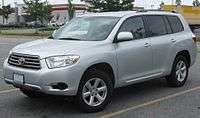 Front
Front.jpg) Rear
Rear
Post-facelift styling
_KX-S_wagon_01.jpg) Front (Kluger KX-S)
Front (Kluger KX-S)_KX-R_wagon_(2015-06-18)_02.jpg) Rear (Kluger KX-R)
Rear (Kluger KX-R)
Safety
| Frontal Driver: | |
| Frontal Passenger: | |
| Side Driver: | |
| Side Rear Passenger: | |
| Rollover: |
All models come standard with enhanced Vehicle Stability Control which immediately alters electric powering steering assist w/traction control (hybrids come standard with VDIM), anti-lock brakes, brake assist and electronic brakeforce distribution. Also standard is a tire pressure monitor, a driver's knee airbag, front seat-mounted side torso airbags, side curtain airbags for all three rows which includes a rollover sensor and active front headrests. Hill Start Assist Control (HAC) is also standard which prevents rolling backwards on slopes, and Downhill Assist Control (DAC) is standard on AWD trims.
The IIHS rates the Highlander "Good" overall in their frontal offset crash test, and good in all subcategories except for "Head/neck," which is rated as "Acceptable."[26] And "Good" overall in the side impact crash test, with "Good" rating in all nine measured categories.[27] The Highlander is also rated "Good" in the roof strength test, giving it a "top safety pick" rating.[28]
In Australasian New Car Assessment Program (ANCAP) testing the Kluger is given a ![]()
![]()
![]()
![]()
![]()
![]()
![]()
![]()
![]()
The safety and effectiveness of the Highlander/Kluger's Vehicle Stability Control system has been questioned by some motoring journalists. During testing for Wheels magazine Car of the Year in 2007, the magazine's editor rolled the vehicle during high-speed gravel road testing. Noting that it was the first such event in the magazine's 45-year history, he criticised the vehicle's stability system stating that "Deficiencies in the Kluger's ESP contributed to the crash". Six of the seven other judges also stated that they felt "the vehicle's ESP performance was sub-standard", and remarked that the vehicle was "almost dangerous on dirt [roads]". In a written response, Toyota disputed the circumstances of the accident and criticised the testing procedures as "unscientific".[30][31]
Hybrid
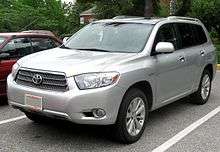
_(cropped).jpg)
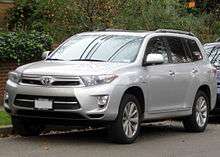
The Kluger Hybrid features Toyota's Hybrid Synergy Drive which continues to allow an electric only powered mode for short distances and speeds. Weight and cost have been improved over the previous hybrid.[32][33]
The expanded size and new features have led to an increase of 500 pounds to its curb weight. All Highlander Hybrids are all-wheel drive, and the EPA has rated the hybrid at 8.7 L/100 km; 32 mpg‑imp (27 mpg‑US) for the city and 9.4 L/100 km; 30 mpg‑imp (25 mpg‑US) for the highway,[34] same as the previous model. The Highlander's fuel economy, while better than the Lexus RX 400h's, lags behind the compact 4cyl Ford Escape Hybrid, which ceased production in 2012, and the latest RX 450h, but still produces significantly fewer emissions than the non-hybrid version with a CARB SULEV rating.
The Highlander Hybrid continues to use the same 3.3-liter 3MZ-FE V6 (208 hp) offered in AWD from the prior model, net power is 175 kW (235 hp). VDIM and Electronically Controlled Brake remain new features include a driver selectable electric only EV mode (when possible) and another ECON mode which restricts acceleration and minimizes air conditioning during acceleration. The Highlander Hybrid Hybrid uses a 1.9 kWh sealed nickel-metal hydride traction battery.[35]
For the 2011 model year the Highlander Hybrid received styling changes and was upgraded with the 3.5-liter 2GR-FXE V6 (245 hp), increasing net power by 7 kW (10 hp), and a powertrain similar to the RX450h. The vehicle is now rated at 8 L/100 km; 34 mpg‑imp (28 mpg‑US) for the city, highway and combined cycles.
Highlander FCHV (2007)
The Highland FCHV was a test vehicle using compressed hydrogen gas, with average fuel economy of 109.9 km/kg (68.3 miles per kilogram) (approximate mpg equivalent).[36]
The vehicle was unveiled at the 2007 LA Auto Show.[37]
Chinese version
The Chinese version of the Highlander (ASU40/GSU45) was unveiled in 2009 at the 13th Shanghai International Automobile Industry Exhibition.[38]
Third generation (XU50; 2013–2019)
| Third generation (XU50) | |
|---|---|
_GXL_wagon_(2015-06-27)_01.jpg) | |
| Overview | |
| Also called | Toyota Kluger (Australia) |
| Production | December 2013[39] – October 2019 |
| Model years | 2014–2019 |
| Assembly | |
| Designer | Matt Sperling (2009)[40] |
| Body and chassis | |
| Platform | Toyota K platform |
| Related |
|
| Powertrain | |
| Engine | |
| Transmission |
|
| Dimensions | |
| Wheelbase | 2,789 mm (109.8 in) |
| Length | 4,854 mm (191.1 in) |
| Width | 1,925 mm (75.8 in) |
| Height | 1,730 mm (68.1 in) |
| Curb weight | 2,045 kg (4,508 lb) |
| Chronology | |
| Predecessor | Toyota Venza |
_GXL_wagon_(2015-06-27)_03.jpg)
On 27 March 2013, Toyota unveiled the third generation XU50 series Highlander at the New York International Auto Show, with plans to have the vehicle reach dealerships in early 2014. Production began on 5 December.[39] This version is longer and wider than the outgoing generation and its design has changed from its boxy look to one that is similar to other mid-size crossover SUVs.
In addition to the changes, this one will feature seating for eight people with a sliding second-row point of entry that gives it 4.3 inches of added width space, soft-touch materials on the instrument panel, lane-departure warning, pre-collision warning and blind spot monitoring systems. HD Radio and Bluetooth will become a standard on all trims for the US version, which will also come equipped with Toyota's Entune multimedia system along with a 6.1-inch touchscreen display audio system. An eight-inch touchscreen system and Toyota's Entune app suite with 12 JBL speakers will be offered as an optional feature. The three powertrain trims that will be offered include a 2.7-liter, six-speed automatic, front-wheel drive base model, a 3.5-liter, six-speed automatic model in both front- or all-wheel drive, and the AWD-only Hybrid trim with a 3.5-liter V6 mated to an eCVT.[41][42]
The Highlander is also approved for use as a New York City taxicab.[43]
2016 facelift
A refreshed 2017 model year Highlander appeared at the New York International Auto Show in March 2016 with sales starting in the fourth quarter of 2016.[44] In V6 powered models, an eight-speed automatic replaced the six-speeder and the revised V6 engine (now designated 2GR-FKS) added Toyota's D4-S direct injection fuel system.[45][46] The new Highlander has a new fascia with restyled headlights and taillights, new SE grade, and XLE and LE Hybrid grades plus new exterior and interior colors.[47]
Pre-facelift styling
_GX_wagon_(2015-11-11)_01.jpg) Front (GX)
Front (GX)_GX_wagon_(2015-11-11)_02.jpg) Rear (GX)
Rear (GX)
Post-facelift styling
_GX_wagon_(2018-09-17)_01.jpg) Front (GX)
Front (GX)_GX_wagon_(2018-09-17)_02.jpg) Rear (GX)
Rear (GX)
Chinese market facelift styling
.jpg) Front (Sport)
Front (Sport).jpg) Rear (Sport)
Rear (Sport)
Safety
| Overall: | |
| Frontal Driver: | |
| Frontal Passenger: | |
| Side Driver: | |
| Side Passenger: | |
| Side Pole Driver: | |
| Rollover AWD: |
| Category | Rating |
|---|---|
| Moderate overlap frontal offset | Good |
| Small overlap frontal offset (driver) (2014–2015) | Acceptable1 |
| Small overlap frontal offset (passenger) | Acceptable2 |
| Side impact | Good |
| Roof strength | Good2 |
- 1 vehicle structure rated "Acceptable"
- 2 vehicle structure rated "Marginal"
- 3 strength-to-weight ratio: 5.40
Fourth generation (XU70; 2019–present)
| Fourth generation (XU70) | |
|---|---|
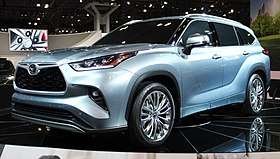 | |
| Overview | |
| Production | November 2019 – present |
| Model years | 2020–present |
| Assembly | United States: Princeton, Indiana (TMMI) |
| Designer | Masaaki Yagi[50] |
| Body and chassis | |
| Platform | TNGA: GA-K[51][52] |
| Related | Toyota Harrier (XU80) |
| Powertrain | |
| Engine |
|
| Electric motor | 5NM (hybrid) |
| Power output |
|
| Transmission |
|
| Dimensions | |
| Wheelbase | 2,850 mm (112.2 in) |
| Length | 4,950 mm (194.9 in) |
| Width | 1,930 mm (76.0 in) |
| Height | 1,730 mm (68.1 in) |
| Curb weight | 1,880–2,018 kg (4,145–4,450 lb) |
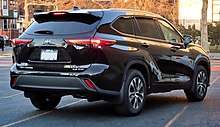
The fourth generation Highlander was unveiled at the New York International Auto Show on 17 April 2019. It is based on the Toyota New Global Architecture (TNGA-K) platform.[51][52][53][54][55] It is offered in five model grades which include the L, LE, XLE, Limited and Platinum. In the United States, the fourth generation Highlander gasoline model went on sale on 18 December 2019 for the 2020 model year. The hybrid model went available in February 2020.
All models come equipped with Toyota Safety Sense 2.0.[56]
Sales
Toyota set a Highlander sales record in the US in 2018, selling 244,511 Highlanders.
| Calendar year | US total sales | US hybrid sales[57] |
|---|---|---|
| 2000[58] | n/a | n/a |
| 2001 | 86,700 | n/a |
| 2002[59] | 113,134 | n/a |
| 2003 | 120,174 | n/a |
| 2004[60] | 133,077 | n/a |
| 2005 | 137,409 | 17,989 |
| 2006[61] | 129,794 | 31,485 |
| 2007 | 127,878 | 22,052 |
| 2008[62] | 104,661 | 19,441 |
| 2009 | 83,118[63] | 11,086 |
| 2010 | 92,121 | 7,456[64] |
| 2011 | 101,252 | 4,549[65] |
| 2012 | 121,055[66] | 5,921[67] |
| 2013 | 127,572[68] | 5,070[67] |
| 2014 | 146,127[69] | 3,621[70] |
| 2015 | 158,915[71] | 4,015[72] |
| 2016 | 191,379[73] | 5,976[74] |
| 2017 | 215,775[75] | 16,864[76] |
| 2018 | 244,511[77] |
References
- Siler, Steve (April 2008). "2008 Toyota Highlander". Caranddriver.com. Retrieved 6 June 2012.
- "2015 Toyota Highlander release date" (Press release). US: Toyota. 19 April 2000. Archived from the original on 7 August 2014.
- Butler, Glenn (1 October 2003). "Toyota Kluger (2003–)". Carpoint.com.au. Retrieved 6 June 2012.
- "Affiliates (Toyota wholly-owned subsidiaries)-Toyota Motor Kyushu, Inc". Toyota Motor Corporation. 2012. Retrieved 14 February 2014.
- The Globe and Mail article
- "Cars Innovation". Safercar.gov. Archived from the original on 5 July 2014. Retrieved 14 January 2014.
- "Safercar.gov". Safercar.gov. Retrieved 20 June 2009.
- "Safercar.gov". Safercar.gov. Retrieved 20 June 2009.
- "IIHS-HLDI: Toyota Highlander". Iihs.org. 23 October 2006. Retrieved 20 June 2009.
- "Status Report" (PDF). US: Insurance Institute for Highway Safety. 19 April 2007. Archived from the original (PDF) on 17 January 2014. Retrieved 17 October 2010.
- "2006 Toyota Highlander Hybrid". Edmunds.com. 9 March 2010. Retrieved 6 June 2012.
- Mathioudakis, Bryon (20 January 2009). "Australian-made Kluger edges closer". GoAuto. Retrieved 27 April 2016.
- "GAC Toyota Motor Co., Ltd". GAC Toyota Motor Co., Ltd. Retrieved 4 March 2016.
- U.S. Patent D566,620
- "2008 Toyota Highlander". Archived from the original on 10 February 2007.
- "2008 Toyota Highlander – Auto Shows". Car & Driver. February 2007. Retrieved 7 February 2007.
- "2008 Toyota Highlander Specs". JB car pages. Retrieved 17 July 2008.
- "2010 TOYOTA HIGHLANDER 2WD". fueleconomy.gov.
- Roth, Dan (3 May 2008). "Toyota halts 2008 Highlander sales as part of recall". Autoblog. Retrieved 27 April 2016.
- "Affiliates (Toyota wholly-owned subsidiaries)-Affiliates (other vehicle assembly cos.)". Toyota Motor Corporation. 2012. Retrieved 27 April 2016.
- "Production of Toyota 'Highlander' Begins in China" (Press release). Japan: Toyota. 25 May 2009. Archived from the original on 6 February 2010. Retrieved 17 October 2010.
- "Toyota Will Build Highlander at New Mississippi Plant". Cars Innovation. Archived from the original on 21 June 2014. Retrieved 27 February 2007.
- "Toyota To Build Prius in U.S: Highlander to Indiana; all Tundra to Texas" (Press release). US: Toyota. Retrieved 13 July 2008.
- Nagy, Chris (24 September 2010). "Toyota Highlander Ascends to New Altitude for 2011". Automoblog.net. Retrieved 17 March 2014.
- "Safercar.gov". 4cars-innovation.blogspot.com. Retrieved 20 June 2009.
- "IIHS-HLDI: Toyota Highlander". Iihs.org. 25 November 2008. Retrieved 20 June 2009.
- "IIHS-HLDI: Toyota Highlander". Iihs.org. 25 November 2008. Retrieved 20 June 2009.
- "Roof strength evaluations: Midsize SUVs". Insurance Institute for Highway Safety. Archived from the original on 2 February 2013.
- "Vehicle Crash Report". ANCAP. Archived from the original on 9 March 2009. Retrieved 20 June 2009.
- Bulmer, Ged; Newton, Bruce (February 2008). "Crash Tackled" (PDF). Wheels. Sydney: 54–55, 78–79. Archived from the original (PDF) on 15 September 2010.
- Newton, Bruce (February 2008). "Wheels COTY 2007: Stage 1 – Proving Ground". Wheels. Sydney. Retrieved 25 June 2010.
- Abuelsamid, Sam (7 February 2007). "Chicago Auto Show: 2008 Toyota Highlander Hybrid, now with EV ONLY mode!". AutoblogGreen. Retrieved 17 March 2014.
- "2008 Toyota Highlander and Hybrid Review". JB car pages. Retrieved 17 July 2008.
- "2008 Toyota Highlander Hybrid Specs". JB car pages. Retrieved 17 July 2008.
- Josh Pihl (January 2014). "Table 33. Batteries for Selected Hybrid-Electric Vehicles, Model Years 2013-2014". Oak Ridge National Laboratory. Archived from the original on 29 November 2014. Retrieved 21 November 2014.
- "Toyota Highlander Fuel Cell Hybrid achieves over 68 MPG on Hydrogen". Blogs.automotive.com. 10 August 2009. Retrieved 17 October 2010.
- Abuelsamid, Sam (14 November 2007). "LA 2007: Toyota Fuel Cell Highlander runs 2300 miles from Fairbanks to Vancouver". Green.autoblog.com. Retrieved 17 October 2010.
- "China-made RAV4, Highlander to Debut in Shanghai" (Press release). Japan: Toyota. 15 April 2009. Archived from the original on 26 July 2011. Retrieved 17 October 2010.
- Crowe, Philippe (6 December 2013). "2014 Toyota Highlander Production Starts, Hybrid Next". hybrid Cars. Retrieved 17 March 2014.
- Schuh, Andrew (13 August 2013). "Who Designed the 2014 Toyota Tundra?". Four Wheeler. Retrieved 16 September 2016.
- "2014 Toyota Highlander Greets The World With NYC Debut" From Autoblog (27 March 2013)
- "2014 Toyota Highlander Review". 2015carreviews.com. Retrieved 16 March 2014.
- "Taxicab vehicles in use". NYC Taxi & Limousine Commission. The City of New York. Retrieved 21 July 2014.
- Korzeniewski, Jeremy (14 March 2016). "2017 Toyota Highlander rolls into New York Auto Show". Autoblog. Retrieved 28 June 2016.
- Lorio, Joe (March 2016). "Updated 2017 Toyota Highlander Revealed". Car and Driver. Retrieved 28 June 2016.
- Ruhi, Joaquín (31 August 2015). "From FSE to FKS: the evolution of Toyota's 2GR 3.5-liter V6". Kaizen Factor. Retrieved 28 June 2016.
- "Toyota's Debut of 2017 Highlander Mid-Size SUV to Showcase Significant Performance Updates" (Press release). Toyota Motor Sales, U.S.A., Inc. 14 March 2016. Archived from the original on 14 March 2016.
- "2016 Toyota Highlander SUV AWD". US: National Highway Traffic Safety Administration. Retrieved 30 September 2015.
- "2015 Toyota Highlander Midsize SUV". US: IIHS. Retrieved 30 September 2015.
- TOYOTA Highlander | Design Overview | Toyota. Toyota Global. Retrieved 25 March 2020 – via YouTube.
- "World Premiere of All-New 2020 Highlander at New York International Auto Show" (Press release). US: Toyota. 17 April 2019. Retrieved 17 April 2019.
- Wendler, Andrew (17 April 2019). "The 2020 Toyota Highlander Is a More Chiseled Version of Itself". Car and Driver. US. Retrieved 17 April 2019.
- Priddle, Alisa (17 April 2019). "2020 Toyota Highlander First Look: You're A Highlander?". MotorTrend. US. Retrieved 17 April 2019.
- Collins, Andrew P. (17 April 2019). "The 2020 Toyota Highlander Hybrid Gets 34 MPG And A Big New Touchscreen". Jalopnik. US. Retrieved 17 April 2019.
- Dowling, Joshua (17 April 2019). "New Toyota Kluger Unveiled Ahead of 2020 Debut, Australia to Get Hybrid Power for the First Time". CarAdvice. Australia. Retrieved 17 April 2019.
- Degen, Matt (18 December 2019). "2020 Toyota Highlander First Review". Kelley Blue Book. US. Retrieved 29 December 2019.
- "U.S. Department of Energy HEV sales figures". Archived from the original on 15 February 2010. Retrieved 17 October 2010.
- "Toyota Sets Sales Record for Sixth Year in a Row". Theautochannel.com. 17 November 2004. Retrieved 20 June 2009.
- "Toyota Announces Best Sales Year in Its 46-Year History, Breaks Sales Record for Eighth Year in a Row". Theautochannel.com. 17 November 2004. Retrieved 20 June 2009.
- "Toyota Reports 2005 and December Sales". Theautochannel.com. Retrieved 20 June 2009.
- "Toyota Reports 2007 and December Sales". Theautochannel.com. Retrieved 20 June 2009.
- "Toyota Reports 2008 and December Sales". Theautochannel.com. Retrieved 20 June 2009.
- "Toyota Reports December And 2009 Sales" (Press release). US: Toyota. Archived from the original on 22 February 2012. Retrieved 27 January 2010.
- Berman, Brad (7 January 2011). "December 2010 Dashboard: Year End Tally". Hybrid Cars. US. Retrieved 11 January 2014.
- Cobb, Jeff (9 January 2012). "December 2011 Dashboard: Sales Still Climbing". Hybrid Cars. US. Retrieved 11 January 2014.
- "December 2012 and Year-End Sales Chart" (Press release). US: Toyota. 3 January 2013. Archived from the original on 6 January 2013. Retrieved 4 January 2013.
- Cobb, Jeff (6 January 2014). "December 2013 Dashboard". US: Hybrid Cars. Retrieved 4 March 2016.
- "December 2013 and Year-End Sales Chart" (Press release). US: Toyota. 3 January 2014. Archived from the original on 8 January 2014. Retrieved 9 January 2014.
- "December 2014 and Year-End Sales Chart" (Press release). US: Toyota. 5 January 2015. Archived from the original on 7 January 2015. Retrieved 6 January 2015.
- Cobb, Jeff (6 January 2015). "December 2014 Dashboard". US: Hybrid Cars.
- Bunkley, Nick (5 January 2016). "Trucks lift Toyota, Lexus". Automotive News. Archived from the original on 11 January 2016.
- Cobb, Jeff (6 January 2016). "December 2015 Dashboard". US: Hybrid Cars. Archived from the original on 11 January 2016.
- "December 2016 and Year-End Sales Chart" (Press release). US: Toyota. 5 January 2017. Retrieved 5 January 2017.
- Cobb, Jeff (5 January 2017). "December 2016 Dashboard". US: Hybrid Cars.
- "December 2017 Sales Chart" (Press release). US: Toyota. 3 January 2018. Archived from the original on 18 July 2018. Retrieved 4 February 2018.
- Cobb, Jeff (4 January 2018). "December 2017 Dashboard". Hybrid Cars. US. Retrieved 4 February 2018.
- "December 2018 Sales Chart" (Press release). US: Toyota. 3 January 2018. Archived from the original on 6 January 2019. Retrieved 10 January 2018.